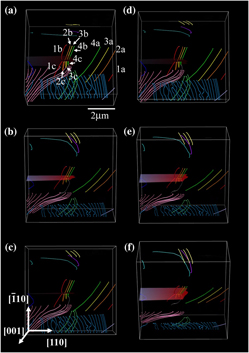Crossref Citations
This article has been cited by the following publications. This list is generated based on data provided by
Crossref.
Robertson, Ian M.
Schuh, Christopher A.
Vetrano, John S.
Browning, Nigel D.
Field, David P.
Jensen, Dorte Juul
Miller, Michael K.
Baker, Ian
Dunand, David C.
Dunin-Borkowski, Rafal
Kabius, Bernd
Kelly, Tom
Lozano-Perez, Sergio
Misra, Amit
Rohrer, Gregory S.
Rollett, Anthony D.
Taheri, Mitra L.
Thompson, Greg B.
Uchic, Michael
Wang, Xun-Li
and
Was, Gary
2011.
Towards an integrated materials characterization toolbox.
Journal of Materials Research,
Vol. 26,
Issue. 11,
p.
1341.
Kacher, Josh
and
Robertson, I.M.
2012.
Quasi-four-dimensional analysis of dislocation interactions with grain boundaries in 304 stainless steel.
Acta Materialia,
Vol. 60,
Issue. 19,
p.
6657.
Kacher, Josh
Liu, Grace
and
Robertson, I M
2012.
Proceedings of the 1st International Conference on 3D Materials Science.
p.
209.
Kacher, Josh
Liu, Grace
and
Robertson, IM
2013.
1stInternational Conference on 3D Materials Science.
p.
209.
Bitzek, Erik
and
Gumbsch, Peter
2013.
Mechanisms of dislocation multiplication at crack tips.
Acta Materialia,
Vol. 61,
Issue. 4,
p.
1394.
Cordier, Patrick
2013.
Minerals at the Nanoscale.
p.
67.
Liu, G.S.
House, S.D.
Kacher, J.
Tanaka, M.
Higashida, K.
and
Robertson, I.M.
2014.
Electron tomography of dislocation structures.
Materials Characterization,
Vol. 87,
Issue. ,
p.
1.
Nogita, Kazuhiro
Tran, Xuan Q.
Yamamoto, Tomokazu
Tanaka, Eishi
McDonald, Stuart D.
Gourlay, Christopher M.
Yasuda, Kazuhiro
and
Matsumura, Syo
2015.
Evidence of the hydrogen release mechanism in bulk MgH2.
Scientific Reports,
Vol. 5,
Issue. 1,
Adhika, Damar Rastri
Tanaka, Masaki
Daio, Takeshi
and
Higashida, Kenji
2015.
Crack tip shielding observed with high-resolution transmission electron microscopy.
Microscopy,
Vol. 64,
Issue. 5,
p.
335.
Tran, Xuan Quy
McDonald, Stuart D.
Gu, Qinfen
Yamamoto, Tomokazu
Shigematsu, Koji
Aso, Kohei
Tanaka, Eishi
Matsumura, Syo
and
Nogita, Kazuhiro
2017.
In-situ investigation of the hydrogen release mechanism in bulk Mg2NiH4.
Journal of Power Sources,
Vol. 341,
Issue. ,
p.
130.
Nogita, Kazuhiro
Tran, Xuan Q.
Yamamoto, Tomokazu
Tanaka, Eishi
McDonald, Stuart D.
Gourlay, Christopher M.
Yasuda, Kazuhiro
and
Matsumura, Syo
2017.
Reply to ‘Comments on “Evidence of the hydrogen release mechanism in bulk MgH2”’.
Scientific Reports,
Vol. 7,
Issue. 1,
Tanaka, Masaki
Sadamatsu, Sunao
and
Higashida, Kenji
2017.
Crack-tip Dislocations and Brittle-to-Ductile Transition.
Materia Japan,
Vol. 56,
Issue. 10,
p.
597.
Nakafuji, Keiichiro
Koyama, Motomichi
and
Tsuzaki, Kaneaki
2020.
In-Situ Electron Channeling Contrast Imaging under Tensile Loading: Residual Stress, Dislocation Motion, and Slip Line Formation.
Scientific Reports,
Vol. 10,
Issue. 1,
Chakraborty, Subhendu
and
Ghosh, Somnath
2021.
A concurrent atomistic-crystal plasticity multiscale model for crack propagation in crystalline metallic materials.
Computer Methods in Applied Mechanics and Engineering,
Vol. 379,
Issue. ,
p.
113748.





